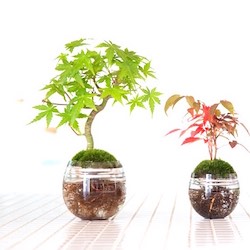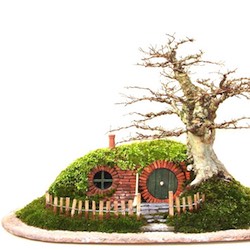This September, the fifth edition of the US National Bonsai Exhibition will take place in Rochester, New York. With over 200 trees on display from all regions of the USA, this is a show not to miss!
The garden of William Valavanis
Interview with William N. Valavanis
Preparations for the 5th edition are in full swing, what can we expect from this year’s exhibition?
This year, like the past exhibitions, visitors can see, study and appreciate some of the finest bonsai from across the United States. Most of the bonsai will be displayed in traditional alcove displays. The exhibition will be held in the same venue as last year at the Total Sports Experience which is composed of TWO indoor soccer fields. Imagine, 55,000 square feet of bonsai! One soccer field will feature over 200 bonsai masterpieces, while the other soccer field will be filled with vendors offering their finest bonsai, pre-bonsai, containers, tools, soils, supplies, display tables, scrolls, suiseki as well as other items for bonsai creation, maintenance and appreciation. The lecture/demonstrations will be held next to the sales area. Green artificial turf covers the floors and is quite comfortable to walk on. As in the past four exhibitions, each bonsai will be professionally photographed for a commemorative album. People who can not attend can still see each tree which was displayed.
The deadline for the “Call for entries” has just passed. Are you happy with the submitted trees?
Yes! A great number of bonsai from across the country have been submitted for the selection process. Generally, the quality has been improving each year, but this year the bonsai are far superior to past exhibitions. Right now, there are over 75 different species and cultivars represented in the exhibition. Submissions are still coming in so the final count is not available.
The USA obviously is a large and diverse country, will that be reflected in the trees on display?
At the exhibition visitors can see large, rugged conifers from the Pacific Northwest, next to dramatic tropical species from Florida, southern bonsai from Texas, as well as delicate and refined bonsai from the Midwest and northeast. Additionally, excellent bonsai from Canada will be included in the special display. Although many of the species have been introduced to the United States, this year a large number of native species will be represented. Classical bonsai, as well as naturalistic bonsai will be next to each other so guests can clearly see the differences in philosophy.

Rocky Mountain Juniper
Brian Hollowell, Norfolk, VA
Wild Olive
Frank Cucchiara, Westwood, NJ
Sharps Pygmy Japanese Maple
Sergio Cuan, Sparta, NJ
The exhibition has grown through the years to become the largest Bonsai event in the US. If you think back on the first edition, what made you decide to organize it?
The United States is a large country and it is difficult to move plants 3,000 miles (one way, 6,000 miles total) in good condition. Having a national show has been discussed in the past for years, but it never happened. So, along with friends, family and sponsor support I tried it. I was warned, many times that it would not be possible to pull off such an event because of the logistics.
I have organized 30 successful symposia in the past and helped to organize numerous exhibitions as well, so I had organizational experience. Working together we tried to organize the 1st U.S. National Bonsai Exhibition in 2008. It was an overwhelming success! So, we continued to expand, improve and develop the exhibition to what it is today.
The U.S. Bonsai Exhibitions are about the BONSAI, not artists or owners. I want to display some of the finest bonsai from throughout the United States. Only the beauty is important, not who created or owns the tree. As long as the bonsai is in the United States, it is eligible for the selection process. Additionally, we have several special invitational exhibits, three of which are from Canada where superb bonsai are created.
What has changed since then?
Since the 1st U.S. National Bonsai Exhibition held in 2008, the bonsai are becoming more refined and beautiful. People are taking the initiative to have a bonsai displayed in the exhibition.
The U.S. National Bonsai Exhibitions are good for bonsai business. People are having custom made containers made for their tree to improve their beauty. The sales of fine sizes annealed copper has increased because it is necessary for branch refinement. Bonsai display tables are being designed and ordered so each bonsai can be presented at its finest. Custom painted scrolls are being purchased as well. Professional bonsai artists have been retained to prepare bonsai for exhibition. Finally, the sales area at the exhibition is filled with vendors from California, Oregon, Florida as well as the rest of the country. If you can’t find what you are looking for in the sales area, it probably does not exist…

American Elm
Suthin Sukolovisit, Stoughton, MA

American species in an American container displayed on an American table
Buttonwood
Paul Pikel, Orlando, FL

Douglas Taylor, Agawam, MA
Finally, can you tell us about the demonstrations at the event?
This year eight lecture/demonstrations will be conducted during the exhibition. Minoru Akiyama from Japan, Enrique Castano from Mexico and Tony Tickle from England will be judging the exhibition as well as presenting programs. Additionally, Peter Warren from England will demonstrate his techniques. Finally, Sean Smith will talk on suiseki and Michael Ryan Bell will be presenting two programs on bonsai containers.
Throughout the exhibition, some of the finest bonsai artists and suiseki authorities will be conducting informal 30 minute critiques of the exhibition. Participating are Bjorn Bjorholm, Kora Dalager, David DeGroot, David Easterbrook, Boon Manakitivipart, Larry & Nina Ragle, Kathy Shaner, Sean Smith and Suthin Sukosolvisit. That’s quite a list of superb authorities from Japan, California, Massachusetts, Washington, Pennsylvania, Alabama and Canada!
All eight of the demonstrations and 18 critiques are FREE with paid admission. Daily tickets are $20, while a weekend pass is $30, before September 1, 2016. Additional information can be seen at: usnationalbonsai.com.




